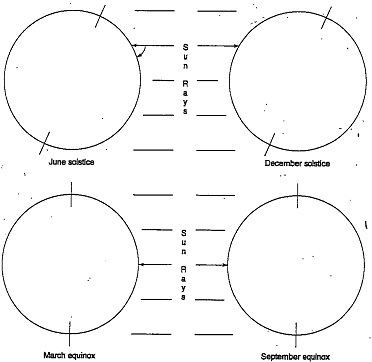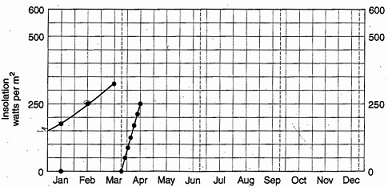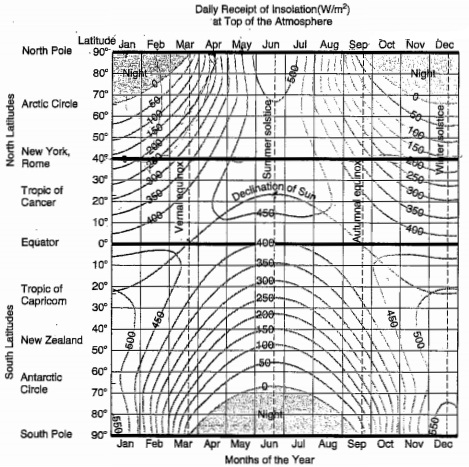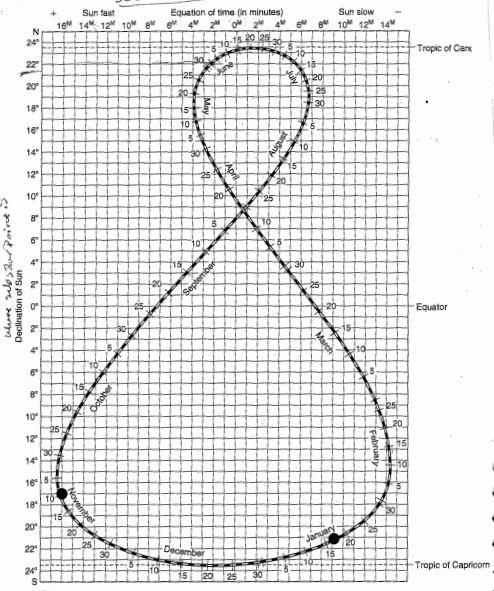Reference no: EM131108157
Lab: Seasons
On the Figure 5.1, complete the following items for each diagram.
1. Extend the suns rays so that they are touching the earth's surface.
2. Label the rays with the appropriate term: YR (for vertical ray), OR (for oblique ray), or TR (for tangent ray)
3. Put an 'X' on the subsolar point
4. Draw the following latitudes as accurately as possible and label them:
a) Equator
b) Tropic of Cancer
c) Tropic of Capricorn
d) Arctic and Antarctic Circle
5. Draw the circle of illumination and lightly shade the portion of earth that is experiencing night

Figure 5.1: Earth-Sun relationships
6. What is the latitude (in degrees) of the subsolar point for each season?
a) June Solstice____
b) Dec. Solstice,
c) March Equinox______
d) Sept. Equinox_____
7. Using the data in figure 5.3, plot and the insolation data for each month for the following locations on the graph provided: Label each line on the graph with their corresponding letter below (a, b, c, d, or e].
a) North Pole (already started for you)
b) New York (already started for you)
c) Equator
d) Tropic of Capricorn
e) South Pole
8. Why does the North Pole exceed the amount of insulation received by the equator during the June Solstice?

In addition, the greater length of travel through the atmosphere at higher latitudes reduces solar intensity due to increased reflection, absorption, and scattering within the atmosphere. This energy receipt also varies daily, seasonally, and annually as Sun angle and daylength varies-less toward the equator, more toward the poles.
A useful altitude at which to characterize insolation is the top of the atmosphere (480 km, 300 mi). The graph in Figure 5.3 plots the daily variation in insolation for selected latitudes. Latitudes are marked along the left side in 10° intervals. The months of the year are marked and labeled across the top and bottom. The dashed curved,Tine shows the declination of the Sun (the latitude of the subsolar point) throughout the year.
To read the graph, select a latitude line and follow it from left' to right through the months of the year. The daily insolation totals are read from the curved lines, given in watts per square meter per day (W/m2 per day). For example, at the top of the atmosphere above 30° N latitude the insolation values (in W/m2 per day) are as follows (readings are approximate cxirapolate when necessary): 240 on January 1; 250 on January 15, and 325-omEebniary 1.

Figure 5.3
Total daily insolation received at the top of the atmosphere charted in watts per square meter by latitude and month. (1 watt/m2 2.064 callcm2/day.) Adapted from the Smithsonian Institution Press from Smithsonian Miscellaneous Collections: Smithsonian Meteorological Tables, vol. 114, 6th Edition. Robert List, ed. Smithsonian Institution, Washington, DC, 1984, p. 419, Table 134.
Find January 17th on the analemma (marked with a dot). It lies on the line labeled 9 minutes, on the "sun slow" side. This means that the sun will reach its "noon" zenith (highest point in the sky on that day) at 12:09 P.M., 9 minutes "late."
9. Use the analemma to find:
a) The subsolar point on November 10 (marked) [17° south latitude]
b) the subsolar point on May 11________________________________________________
c) the subsolar point today__________________________________________
d) the date(s) when the declination is 9° S______________________________________
e) the date(s) when the declination is 21° N____________________________________
10. At what clock time does the Sun actually reach zenith on:
October 13? [13 minute behind time]
March 8?_______________________________
May 20?_______________________________
Today?________________________________
As we have noted, the noon Sun angle changes at any given latitude throughout the year. Using the analemma to determine the subsolar point (Sun's declination), you can calculate the altitude of the noon Sun (Sun L for any location by using the following formula:
∠ = 90° - (arc distance between your latitude and subsolar point)
*Note: You would observe the same Sun altitude on August 25 when the subsolar point is once again at 10° N. If you end up with a negative value for our Sun altitude, then the Sun is below the horizon and will not be visible on that day-as someone might experience north of the Arctic Circle in the Northern Hemisphere winter.
11. You are vacationing at Disney World near Orlando, Florida (28°32' N) on June 3. At what altitude will you observe the noon Sun? Include correct horizon. (Show work)
∠ = 90° - (arc distance between your1latitude and subsolar point)
∠ = 90° - (28°32' N subsolar point)
12. On that same day friends of yours are sightseeing at Iguagu Falls in Brazil (25°41' 5); at what altitude will t they observe the noon Sun?
13. Calculate the altitude of the noon Sun if you are vacationing in Kuala Lumpur, Malaysia (3°10' N) on July 25.

Figure 5.4 The analemma